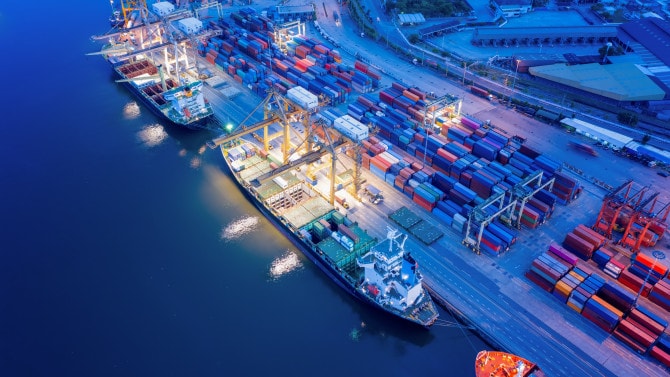{{item.title}}
{{item.text}}

{{item.text}}
After a record-breaking year for M&A in 2021, optimism for another supercharged year in 2022 remains, despite growing market headwinds.
Global mergers and acquisitions (M&A) hit new highs in 2021—breaking prior records by a long shot. The number of announced deals exceeded 62,000 globally in 2021, up an unprecedented 24% from 2020. Publicly disclosed deal values reached all-time highs of US$5.1tn—including 130 megadeals with a deal value greater than US$5bn—a whopping 57% higher than in 2020 and smashing the previous record of US$4.2tn set in 2007. The often-frenzied M&A activity in 2021 was fuelled by intense demand for technology, and for digital and data-driven assets, and the pent-up deal-making demand from 2020 that was unleashed.
We don’t expect these records to be smashed in 2022. But all the indications point to another supercharged year. Economic optimism remains high, there’s a strong deals pipeline, capital is in abundance, and companies across all industries badly need technology. It is true that there are growing headwinds. The trifecta of low operating costs, lower regulation and taxes, and ever lower interest rates have, over the past decade, helped companies achieve year-on-year earnings growth, pushed stock markets to seemingly endless record highs, and generally spurred M&A. But now, each of those pillars is facing pressure for the first time in a decade, as the pandemic has disrupted the status quo. As a result, higher interest rates, rising inflation, increased taxes and greater regulation could introduce structural or financial hurdles or delays for deals in 2022. We are already seeing greater volatility in financial markets, further disruptions in the global supply chains and increased levels of fiscal debt, as shockwaves from the pandemic continue to play out globally. As we’ve already learned from the pandemic, dealmakers should stay alert to how the new accelerated pace of change can bring these factors—or others—into play earlier and with greater impact.
Even so, business leaders are seemingly undaunted by these macroeconomic headwinds. For the second year in a row, PwC’s annual global CEO survey, the 25th edition of which was published in January 2022, has found that 77% of CEOs expect global economic growth to improve during the year ahead. Furthermore, more than half of CEOs reported high levels of confidence for revenue growth in their own companies over the next 12 months; led by CEOs of private equity (67%) and technology companies (64%), two sectors which saw the highest M&A volumes and values in 2021.
“After a record year for M&A, everyone’s asking what’s next? Deal-making will likely remain robust in 2022, with fierce competition among corporates, PE and SPACs, but it’s feasible that the top may come off the market, given increasing macroeconomic and regulatory headwinds.”
By all accounts, the factors that contributed to the record M&A market in 2021 will remain influential for deal-making in 2022. Led by intense competition between corporates, private equity (PE) and special purpose acquisition companies (SPACs), valuations are also expected to remain high. PE deals have been on a particularly impressive run, and are on course to grow their share of M&A. Almost 40% of deals in 2021 involved a PE fund, up from just over a quarter over the past five years. PE firms aren’t just doing more deals, they are doing bigger ones; and this is accounting for 45% of total deal values in 2021, compared to 30% over the past five years. On the corporate side, we expect the strategic shift to digital, innovative and new disruptive business models to continue to drive M&A decision-making. With market conditions that demand a greater value creation mindset across global boardrooms, CEOs will also likely focus on divestitures, as they rebalance their portfolios for longer-term growth and profitability.
The record levels of deal-making in 2021 were evident across all three regions, reflecting the strong bounce-back in the global economy. Europe, the Middle East and Africa (EMEA) showed the greatest growth in deal volumes over the prior year, with an increase of 34%, followed by the Americas with 22%, and Asia-Pacific with 17%. Although the volume of deals in 2021 was approximately the same across the three regions, deal value was more heavily weighted towards the Americas, with over 50% of deal values and approximately 60% of megadeals.
Technology-focused deals continued to dominate the landscape, as companies sought to acquire technology capabilities and transform their business models. The robust SPAC IPO (initial public offering) market in late 2020 and early 2021, combined with a resurgence in SPAC IPOs in late 2021, means that there remain almost 500 SPACs yet to announce a merger that will need to close a deal by late 2022 or early 2023. As such we expect SPACs will continue to play a significant role in M&A in 2022, as they continue to compete against corporates and PEs for sought-after assets.
Private equity's impact on M&A is growing. In addition to 2021 being a record year for fundraising, PEs also put record amounts of capital to work. Global PE dry powder ended 2021 at US$2.3tn, 14% higher than the start of the year—highlighting that there is plenty more M&A to come in 2022. However, fierce competition continues to push up multiples, which has created more pressure on the PE industry to generate returns. That means there is a greater need for financial buyers to bring deeper operational expertise, a greater focus on responsible investment (ESG) and a sharper focus on value creation than ever before. Those able to generate above average returns will be rewarded by increased investor interest, enabling them to deploy these funds through M&A activity in 2022. We expect PE will respond with a number of different investment strategies:
“Increased investor capital, higher multiples and rising interest rates are building pressure on private equity firms to generate returns. Their response is to up their game by undertaking larger, more complex and potentially riskier deals, while focusing on value creation and data-driven strategies.”
Deals in the US$1bn–US$5bn range have typically been the sweet spot for PE firms. But we expect to see a growing appetite among PE for larger and more complex deals. Examples include the US$30bn acquisition of Medline Industries, Inc., by a partnership comprised of funds managed by Blackstone, Carlyle and Hellman & Friedman, and the proposed US$14bn acquisition of McAfee Corp. by an investor group led by Advent and Permira, Crosspoint Capital, Canada Pension Plan Investment Board, GIC, and a wholly-owned subsidiary of the Abu Dhabi Investment Authority.
Large PE funds are likely to target assets in alternative markets, such as insurance and asset management, and, in particular, private wealth.
Traditionally, PEs have shied away from the more risky, early-stage highly innovative companies without proven business models. However, we are seeing growing PE interest in these types of companies as the pace of innovation increases and the cost decreases.
Investor interest in PE assets may allow funds to hold on to investments for longer than the standard five to seven years—for example, through the use of longer-dated continuation funds and other PE-to-PE transactions. This may afford PE firms more time to potentially overcome high valuations, particularly in an environment where future multiples may contract.
PEs are increasingly applying technology and data-driven strategies to all aspects of their operations—from how they screen potential investments, monitor portfolio performance, create value and manage a successful exit.
At the outset of the pandemic, efficient operations and access to capital helped many large corporations fare better than their smaller, less-well-capitalised competitors. One might conclude this will lead to further consolidation, as companies use M&A to gain the advantages of size and scale. However, a number of large established corporations, including IBM, Daimler, General Electric, Johnson & Johnson and Toshiba, have recently announced demergers or divestitures, effectively doing the opposite—breaking up their business in order to focus on the core operations. Several factors are driving this fundamental reorientation in global boardrooms. Shareholder activist campaigns have prompted corporate boards to conduct strategic portfolio reviews and divest underperforming or non-core businesses. CEOs are also placing an increasing value on the ability to be nimble—to quickly react to changing customer behaviours and business model disruption. In some cases, the desire for greater financial and operational agility and a focus on industry-specific dynamics now appear to outweigh the traditional benefits of scale and conglomeration. These forces will likely lead to further divestitures in 2022.
The tightening regulatory environment in many countries will likely create headwinds for dealmakers in 2022, especially those deals that invite antitrust or Foreign Direct Investment (FDI) scrutiny. In the US, the Department of Justice appears to be taking a harder line on corporate mergers, with several recent rulings to block deals based on antitrust concerns. In Europe, antitrust investigations are underway against several US tech giants. In Asia-Pacific, the Chinese government is implementing anti-monopoly, data security and industry-specific regulations; and Japan’s Fair Trade Commission is investigating big tech’s dominance in the smartphone operating system market. Rising protectionism, such as policies relating to semiconductor technology, may also make it challenging for certain deals to gain approval and could result in a greater focus on domestic deals and, correspondingly, less cross-border M&A activity.
Companies continue to leverage M&A to build agility and resilience against the prevailing headwinds. Shoring up supply chains has been an area of particular interest. We expect 2022 will bring more vertical-integration deals, both upwards, to secure key raw materials or components, and downwards, to control how products are distributed. Many companies contending with raw material, input or labour shortages, port lockdowns, shortages of shipping containers—especially those in the manufacturing, pharmaceutical and medical devices sectors—are now focused on onshoring or nearshoring opportunities in order to reduce lead times and build greater resilience into their supply chains. We also expect strong investor interest in technology companies specialising in supply chain processes, particularly those able to capture and leverage data and analytics.
Environmental, social and governance (ESG) factors are increasingly taken into account in M&A decision-making and strategy, as investors use ESG criteria to assess risks and to identify value creation opportunities. For example, in PwC’s Global Private Equity Responsible Investment Survey 2021, we discovered that more than half of all respondents had either refused to enter an agreement with a general partner or turned down a potential investment on ESG grounds. With increasing commitments being made to reduce carbon emissions by companies and PE funds, we anticipate increased capital will be mobilised for transition to greener sources of energy, creating opportunities for M&A, not just in the heavier carbon-emitting sectors but in those which innovate to develop the new technologies for the future. We also expect to see increased M&A in industries that are transitioning to new business models, such as the major oil and gas companies—as they pivot to invest in renewables and hydrogen—or in the technology industry, where companies are innovating around energy storage or solutions to create a more sustainable circular economy.
“We’ve seen deals lead the way to economic recovery—looking forward, I expect M&A will continue to play a pivotal role for companies navigating technological disruption and increasing pressure from stakeholders to unlock value in their companies and portfolios.”
Overall, we remain optimistic about the year ahead, with deal volume and valuations continuing to reflect a dynamic market and an abundance of capital. On the one hand, with technological adaptation now a consistent pressure across all industries, we believe that competition for targets will be strong. Companies will also seek to maintain competitive advantage and reinvest using divestitures of non-performing businesses across global markets.
On the other hand, dealmakers must keep close attention on a number of expected and potential disruptions, which could signal delays in deals getting done, including volatility in financial markets and macroeconomic headwinds. As these and other risks mount for CEOs and institutional investors, robust plans for M&A value creation are more important than ever.
About the data
We have based our commentary on M&A trends on data provided by industry-recognised sources. Specifically, values and volumes referenced in this publication are based on officially announced transactions, excluding rumoured and withdrawn transactions, as provided by Refinitiv as of 31 December 2021 and as accessed on 2 January 2022. This has been supplemented by additional information from Dealogic and our independent research, and includes data derived from data provided under license by Dealogic. Dealogic retains and reserves all rights in such licensed data. Certain adjustments have been made to the source information to align with PwC’s industry mapping.
{{item.text}}

{{item.text}}






















